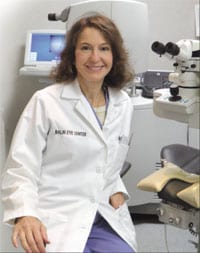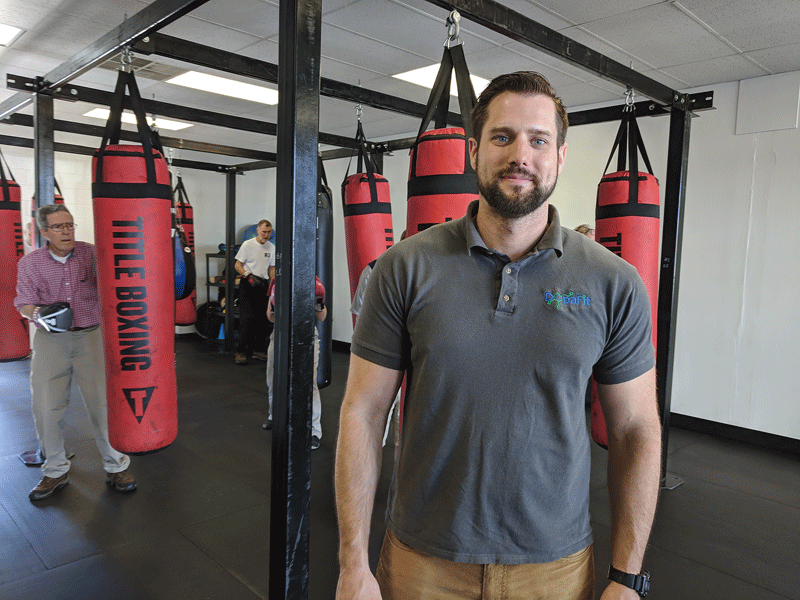Contacts or Surgery? Patients See Advances in Both Kinds of Vision Correction
When Sarah Rivera was in college, she rarely removed her contact lenses. “I slept in them and didn’t take them out for days at a time because I was too busy,” she said. As a result of improper lens care hygiene, Rivera developed a severe infection. “I got a corneal ulcer which was incredibly painful.”
The infection healed, but about six years later Rivera opted for a permanent solution — laser surgery to correct her nearsightedness. “Today, I am able to swim and be more active without having to deal with glasses or contact lenses,” she said. “Plus, my peripheral vision improved.”
Rivera is one of millions of people who have sought alternatives to wearing eyeglasses. In the past decade, amazing advances have been made in this arena, but scientists and researchers have been taking steps to eliminate the need for eyeglasses for more than 500 years. In fact, Leonardo da Vinci came up with the first illustrations for contact lenses in 1508.
Today, they are used to correct nearsightedness, farsightedness, and astigmatism and are effective, safe, far more comfortable than in the past, and even healthier, as new materials allow more oxygen to get to the eye.
“The notorious hard contacts from the old days have come a long way,” said Dr. John Papale of the Papale and Bouvier Eye Center in Springfield.
“They don’t stress the eye as much, and problems are not as common as they used to be. But they require maturity, as people must keep them clean and dispose of them at the appropriate time, although disposable lenses obviate the need for meticulous care,” he explained, referring to contacts that are worn for one day and then thrown away.
The U.S. Food and Drug Administration approved continuous-wear contacts about 10 years ago, but studies since that time show that wearing contact lenses overnight can lead to irritation and infection. So, as society and technology advance, a growing number of people are choosing laser eye surgery and implantable contact-lens surgery as a permanent solution.
But fears and misconceptions still exist about laser eye surgery, which reshapes the cornea of the eye and makes it easier to focus.
“The biggest barrier is fear. People say, ‘if it was my hand, foot, or another body part, I would be relatively fearless.’ But fear presents a significant barrier,” said Papale.
This month, the HCN looks at the benefits and disadvantages of contact lenses and the surgeries available to correct vision problems.
Continuum of Care
Dr. Christopher Dostal of Northampton Eye Surgeons fits many teens and preteens with contact lenses. They are not candidates for laser surgery, as their eyes are still changing, and do so until they reach their early 20s.
“We’re seeing more and more young people who don’t want to wear glasses, and we are fitting kids with contacts at age 12 or 13, which is a lot younger than in the past,” he said.
Dostal says there are pros and cons to wearing contact lenses. On the positive side, people who use them have better peripheral vision, can wear regular sunglasses, and find it easier to play sports. “And a lot of people just like the freedom of not having the frame of their glasses in front of them all of the time,” Dostal said.
The downside is that they require close attention to hygiene and can cause irritation or infection if instructions are not followed carefully. In addition, people who wear contacts must remember to wear safety glasses when doing jobs where something could fly into their eye. Dostal said people who have worn glasses for years can forget to take this precaution, as they are accustomed to having a shield in front of their eyes.
Due to the danger of infection, young patients at Northampton Eye Surgeons are not given contacts until they have gone through a screening process to ensure that they are responsible and their parents plan to oversee their use and daily care. This involves a trial fitting to make sure the contacts fit properly and the prescription is correct, as well as a followup visit to make sure no trouble is brewing.
“In some instances, the eyes may begin drying out or become irritated. The patient may not feel it, but we can we can see microscopic changes that are taking place,” Dostal said, adding that the situation is rare, but one that cannot be ignored. “And we have seen eye infections that occur related to overuse.”
When this occurs, it is necessary to discontinue using the contacts until the eyes heal. “So people who wear contacts still need a good backup pair of glasses,” he said, explaining that he does a lot of refitting of contacts due to evidence that changes are occurring in the cornea or surface of the eye.
A healthy option is daily disposable lenses, which are chosen by people who don’t want to be bothered with cleaning, have developed an allergy to cleaning solutions, or want contacts only for occasional use. “We see a lot of patients who only use contacts part-time, on weekends, or when they are playing sports,” Dostal said.
The lenses come in sealed packets and have a long shelf life. Although they are more expensive, many patients feel that the advantages in eye health outweigh their cost.
Dr. Nancy Balin of Balin Eye and Laser Center says disposable lenses can be fantastic, but people can still develop allergies to them. In addition, some people can’t stand the sensation of having something in their eye. Plus, there are risks for infection. “If an infection is caught early, it can be treated with antibiotics, but it can cause scarring,” she said. “If the eye becomes red, it is a red flag that the contact lenses need to be removed and the person needs to get checked out.”
J. Peter Bouvier, a corneal specialist at Papale and Bouvier Eye Center, explained that “people can develop allergies which lead to chronic, low-grade infection and subsequent dry-eye disease, which can put them at risk of infection of the cornea. In extreme cases, it can create such severe scarring that a corneal transplant is necessary.
“In addition,” he noted, “soft contact lenses don’t do a good job of correcting vision in people with irregular astigmatism or those who suffer from chronic blepharitis, which causes oily deposits around the eyes that are often colonized by bacteria.”
“People have to be very motivated to wear contacts,” Balin said. “The alternative is laser surgery, which has become very popular.”
Surgical Options
Lasik surgery involves reshaping the cornea of the eye, and attempts to accomplish this began in the 80s. “In the early years, doctors removed a part of the cornea, froze it, used a machine to reshape it, and then transplanted it. It was very complicated, very expensive, and wasn’t precise enough to become mainstreamed,” Papale said.
The main forerunner to laser surgery was photorefractive keratectomy or PRK, which is sometimes still done today. The difference between the two surgeries is that, during PRK, the laser treatment is directed on the cornea rather than under a small flap on the cornea. It requires a longer recovery period, but in some cases, is more appropriate for a patient.
“If someone’s cornea is very thin, this surgery may be a safer option,” Balin said. Both surgeries are fast and painless; they take about three minutes per eye, and only about 30 to seconds of that involves using the laser.
“Lasik surgery is the number-two surgery in terms of popularity in the U.S. About 1 million surgeries take place every year, and the success rate is over 98{06cf2b9696b159f874511d23dbc893eb1ac83014175ed30550cfff22781411e5},” Papale said.
It is typically done in an ophthalmologist’s office while the patient is awake. “Anesthetic drops are used to numb the eye, and the person doesn’t see or feel the laser beam,” he said.
However, people over age 40 who suffer from presbyopia, or ‘aging eyes,’ will still need reading glasses, unless they opt to have monovision Lasik surgery, which corrects one eye for near vision and the other for distance. The brain has to adapt to the change, however, and although some people do well with it, most doctors have patients simulate monovision via contact lenses to determine if it is a suitable option. But only a small minority of surgeries are done for this reason. “Ninety-two percent of people who have laser surgery do it to correct their distance vision,” Balin said.
A new type of vision correction lens can also be implanted in the eye, and Papale is one of only a few surgeons in Western Mass. qualified to do the surgery. Candidates for the procedure are patients who have moderate to severe nearsightedness and are typically between age 21 and 45.
The procedure involves inserting a special lens through a microincision made in the eye, then placing it behind the iris in front of the eye’s natural lens. Clinical studies show that approximately 95{06cf2b9696b159f874511d23dbc893eb1ac83014175ed30550cfff22781411e5} of people are happy with the implants.
“The surgery is done under a microscope and takes about 15 or 20 minutes. It is appropriate for people who are nearsighted and very useful for those who are too nearsighted to benefit from Lasik surgery,” Papale said. “The recovery time is very fast, and, in general, vision is much sharper after surgery with the implantable lens. Plus, it’s a procedure that only needs to be done once.”
Quality of Life
Lasik surgery is not covered by insurance, and costs about $4,000 locally. But for millions of people, it is life-changing.
“No one needs it to save their life, but many famous people have had it, including Dustin Hoffman, Courteney Cox, Tiger Woods, and Regis Philbin, who had the surgery in his 70s,” Papale said. Which proves that it’s never too late to see clearly — and leave your glasses behind.


